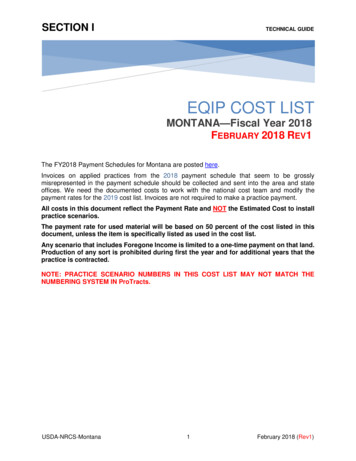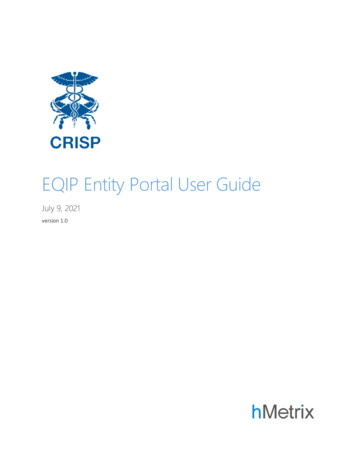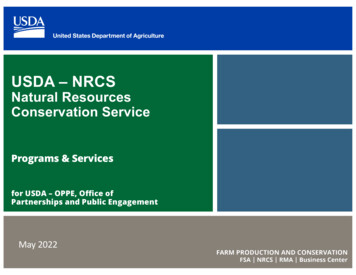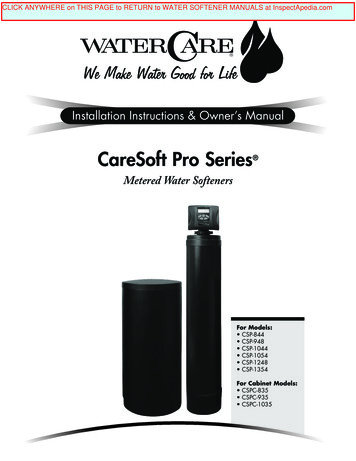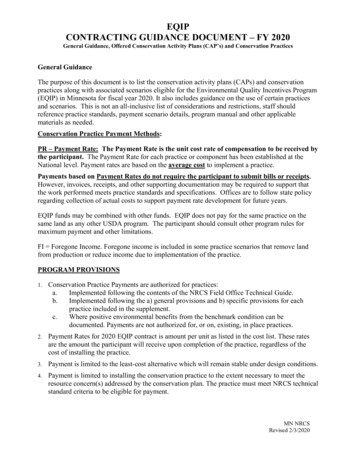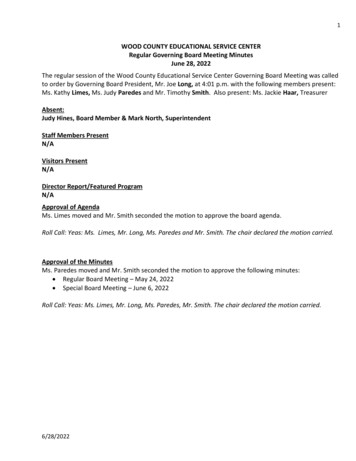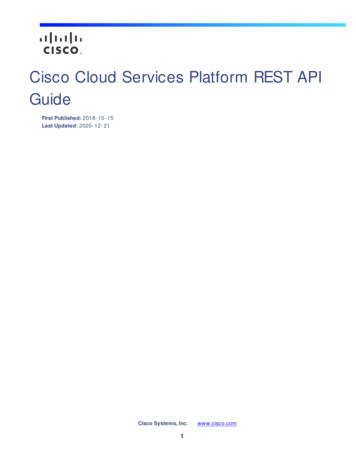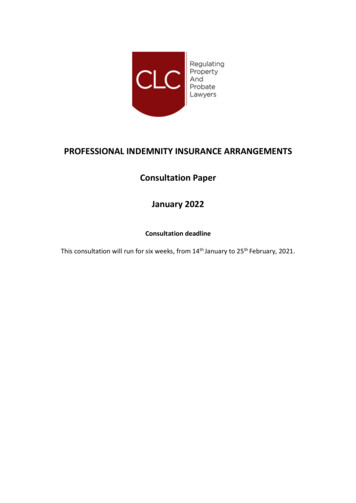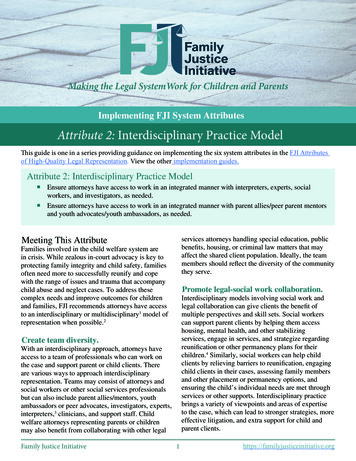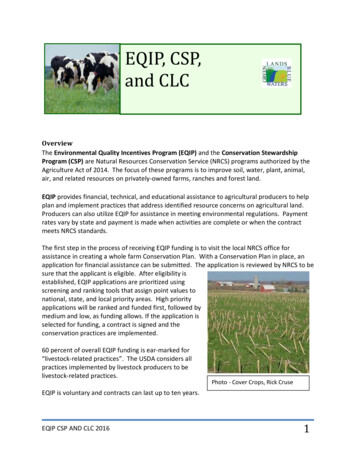
Transcription
EQIP, CSP,and CLCOverviewThe Environmental Quality Incentives Program (EQIP) and the Conservation StewardshipProgram (CSP) are Natural Resources Conservation Service (NRCS) programs authorized by theAgriculture Act of 2014. The focus of these programs is to improve soil, water, plant, animal,air, and related resources on privately-owned farms, ranches and forest land.EQIP provides financial, technical, and educational assistance to agricultural producers to helpplan and implement practices that address identified resource concerns on agricultural land.Producers can also utilize EQIP for assistance in meeting environmental regulations. Paymentrates vary by state and payment is made when activities are complete or when the contractmeets NRCS standards.The first step in the process of receiving EQIP funding is to visit the local NRCS office forassistance in creating a whole farm Conservation Plan. With a Conservation Plan in place, anapplication for financial assistance can be submitted. The application is reviewed by NRCS to besure that the applicant is eligible. After eligibility isestablished, EQIP applications are prioritized usingscreening and ranking tools that assign point values tonational, state, and local priority areas. High priorityapplications will be ranked and funded first, followed bymedium and low, as funding allows. If the application isselected for funding, a contract is signed and theconservation practices are implemented.60 percent of overall EQIP funding is ear-marked for“livestock-related practices”. The USDA considers allpractices implemented by livestock producers to belivestock-related practices.Photo - Cover Crops, Rick CruseEQIP is voluntary and contracts can last up to ten years.EQIP CSP AND CLC 20161
CSP rewards producers by providing an annualpayment for improving, maintaining, and managingexisting conservation activities as well as forundertaking additional conservation activities.The process of applying for funding involvesworking through the Conservation MeasurementTool (CMT) with a NRCS staff member. The tooldetermines the farmer’s baseline conservationperformance. If the baseline score is too low to beeligible for funding under CSP, EQIP funding can beutilized to bring the farm up to the required level. Ifthe score is high enough and the farmer qualifiesfor CSP, the next step is to apply. Based on currentconservation performance, and future conservationactivities, the farmer receives environmentalbenefit payment points. Payment rate is multipliedby environmental points and number of acres.NRCS selects the highest scoring applications, basedon current performance and future plans, until allacres allotted to that particular state, for a givenyear, are allocated. Approximately twice as manyfarmers apply as get approved for funding.Maximum annual payment per farm is 40,000.RCCRsBecause of the many benefits provided byResource-Conserving Crop Rotations(RCCRs), the Farm Bill offers a“supplemental payment” for theiradoption and improvement under CSP.RCCRs can include perennial grass, alegume, a legume-grass mixture, or asmall grain grown in combination with agrass or legume that is used as a greenmanure. This payment is a CSPsupplemental payment option and istherefore above and beyond the CSP peracre payment rate.CSP is a voluntary program, contracts last five yearsand can be renewed.Continuous Living Cover (CLC) refers to the conceptof keeping plant cover on the land all year long.Green Lands Blue Waters promotes five CLCstrategies: agroforestry, cover crops, perennialforage, perennial grains, and biomass his chapter was created to explore different ways Farm Bill funding might support continuousliving cover strategies and systems.EQIP CSP AND CLC 20162
Conservation Activities – The Toolbox for Increasing Continuous Living CoverBoth EQIP and CSP utilize NRCS conservation activities to meet conservation goals. EQIP uses aset of conservation activities referred to as conservation practices. CSP utilizes the sameconservation practices as well as additional activities called enhancements. As of 2015, NRCSlists 35 conservation practices and 119 enhancements. Table 1 shows a subset of NRCSconservation practices and Table 2 shows a subset of NRCS enhancements, selected becausethey have the potential to support CLC strategies in the Upper Mississippi River Basin states ofIllinois, Iowa, Minnesota, Missouri, and Wisconsin. The tables provide an overview of the actualor potential relationship between conservation activities and CLC strategies.EQIP CSP AND CLC 20163
Table 1: NRCS conservation practices to be used with EQIP and/or CSP and the CLC strategies thatmight be supported by each in the Upper Mississippi River 45739601380650Practice NameAlley CroppingConservation CoverConservation Crop RotationContour Buffer StripsContour Orchard & OtherPerennial CropsCover CropCritical Area PlantingCross-Wind Trap StripsEarly Successional HabitatDevelopment/ ManagementField BorderFilter StripForage and Biomass PlantingForage Harvest ManagementGrassed WaterwayHedgerow PlantingHerbaceous Wind BarriersIntegrated Pest ManagementMulti-Story CroppingPrescribed GrazingRange PlantingRiparian Forest BufferRiparian Herbaceous CoverSilvopasture EstablishmentStreambank & ShorelineProtectionTree & Shrub EstablishmentTree & Shrub Site PreparationUpland Wildlife HabitatManagementVegetated Subsurface DrainOutletVegetative k/ShelterbeltRenovationEQIP CSP AND CLC 2016Forage BiomassXXCLC CoverCropsXXXXXXXXXXXXXXXXXXXXXXX4
Table 2: NRCS enhancements to be used with CSP and the CLC strategies that might be supported byeach in the Upper Mississippi River Basin.ActivityCodeEnhancement CR99ENR11ENR12PLT06PLT15PLT16Prairie Restoration for Grazing and WildlifeHabitatOn-Farm Forage Based Grazing SystemExtend Existing Filter Strips or RiparianHerbaceous Cover for Water QualityProtection and Wildlife HabitatEnhance Wildlife Habitat on ExpiredGrass/legume Covered CRP Acres or Acreswith Similar Perennial Vegetated CoverManaged as HaylandPrescriptive Grazing Management Systemfor Grazing LandsExtending Riparian Forest Buffers for WaterQuality Protection and Wildlife HabitatExtending Existing Field Borders for WaterQuality Protection and Wildlife HabitatMulti-Species Native Perennials and NativeSelf-Seeding Annuals for Biomass/wildlifeHabitatImproved Resource Conservation CropRotationResource-Conserving Crop RotationImproving Energy Feedstock ProductionUsing Alley Cropping Systems with ShortRotation Woody CropsUse of Legume Cover Crops as a NitrogenSourceRenovation of a Windbreak, Shelterbelt orHedgerow for Wildlife HabitatEstablish Pollinator and/or Beneficial InsectHabitatIntensive Rotational GrazingEQIP CSP AND CLC 2016ForageCLC StrategiesPerennial AgroCoverBiomass Grainsforestry CropsXXXXXXXXXXXXXXXXXXXXXXXXXXXXX5
WQL10WQL26High Residue Cover Crop or Mixtures of HighResidue Cover Crops for Weed Suppressionand Soil HealthUse of Cover Crop MixesUse of Deep Rooted Crops to Breakup SoilCompactionConversion of Cropped Land to Grass-BasedAgricultureCrop Management System where Crop LandAcres were Recently Converted from CRPGrass/legume Cover or Similar PerennialVegetationCover Cropping in Orchards, Vineyards andOther Woody Perennial Horticultural CropsIntensive Cover Cropping in Annual CropsIntegrate Grazing into Crop and ForestSystemsHigh Species Diversity Grazing LandsSoil Health Crop RotationPlant a Cover Crop that will ScavengeResidual NitrogenReduce the Concentration of NutrientsImported on FarmXXXXXXXXXXXXXXXXXXXXXXCSP offers the opportunity to increase ranking points and payments by allowing the farmer tochoose “bundles” of enhancements. Bundles are groups of enhancements that areimplemented together. Choosing a bundle increases ranking points and payments more than ifenhancements are chosen individually from the available list of options.CSP Bundle Example: Pasture Enhancement Bundle BPA10 (improvesforage utilization) combines the following enhancements:ANM25-Stockpiling of forages to extend the grazing seasonANM29-On-farm forage based grazing systemANM64-Managing livestock parturition to coincide with forage availabilityPLT16-Intensive rotational grazingWQL07-Split nitrogen applications 50% after the crops/pasture emerge/green-upFor a more in-depth description of these practices and enhancements as they relate to CLC,EQIP CSP AND CLC 20166
please see Table 5 and Table 6 at the end of this chapter.How Conservation Activities are Prioritized to Address Local ConcernsEach individual state chooses which conservation activities it will fund based on local concerns.Groups at the county and state level assist the State Conservationist in deciding whichconservation activities will be funded. The State Technical Committee (STC) directly advises theState Conservationist to assist in making technical decisions. The STC listens torecommendations on the county level from Local Work Groups (LWGs). This way the StateConservationist can guide national programs that address needs on a local level (United StatesDepartment of Agriculture Natural Resource Conservation Service, 2006).In addition to representatives from Federal and State agencies, STC and LWG membershipincludes “individuals with conservation expertise, agricultural producers, nonprofitorganizations, persons knowledgeable about conservation techniques and programs, andrepresentatives from agribusiness” (United States Department of Agriculture Natural ResourceConservation Service, 2006). The meetings are open to the public. Citizens are welcome tovoice concerns and offer input regarding conservation as it applies to agriculture.Figure 1 summarizes how EQIP practices and priorities are formed and implemented from thenational level down to the local level.EQIP CSP AND CLC 20167
Figure1. How the Environmental Quality Incentives Program (EQIP) isPrioritized and ApprovedLocalStateNationalNRCS Program ManagementPublic ParticipationCongress authorizes programs in Farm Bill & appropriates fundingPublic provides informationto CongressUSDA NRCS writes and periodically updates nationalconservation practice standards and ranks these based onnational prioritiesPublic provides informationto NRCS for revision ofnational practice standardsState Conservationists addcriteria to standards, rankspractices, and implementsprograms based on rankand input from StateTechnical CommitteeNRCS Conservationistsprovide technicalassistance and funding tofarmers based on rankand input from LocalWorking GroupsState TechnicalCommittee, withsubcommittees,identifies state resourceconcerns & advises StateConservationistLocal Working Groups provideinformation and recommendations tothe District Conservationist and StateTechnical CommitteePublic participates on STC andsubcommittees and provides inputto state standards and prioritiesPublic provides input to localpriority settingFarmers prepare conservationplans, submit applications forfunding, and implementprojects8
Prairie STRIPS - One of Many Examples of How NRCS Programs Might Fund OnFarm ConservationIn light of the concerns associated with erosion and runoff, Iowa State University and severalpartners formed STRIPS (Science-based Trials of Row-crops Integrated with Prairie Strips). TheSTRIPS project has been collecting data on the benefits of adding perennial native plants toconventional row-crop settings. The research provides hard data that shows how convertingjust 10% of a crop field to perennial natives, can reduce the loss of topsoil by 90% (Helmers etal., 2012).The assistance that the STRIPS project provides is informational only and does not providefunding.Several of the NRCS EQIP and CSP funded activities, presented in this document, allow for andfund the types of placement of perennial species on the landscape that the STRIPS project hasshown to be so beneficial. In most cases, when native plants are allowed under a conservationactivity, the payment rate is higher for natives than for non-natives to cover the higher cost ofimplementing natives. Additionally, some of the conservation activities allow for the harvest ofthe native perennials placed on the field. Native prairie plants can be grazed, hayed, andharvested for forage or energy biomass.Tables 3 & 4 show NRCS activities that relate to prairie strips.By strategically placing these conservation activities on the field and incorporating nativeperennials, multiple benefits can be realized. The benefits include habitat for wildlife,pollinators and beneficial insects, improved soil health and fertility, reduced loss of topsoil andnutrients, better resilience during heavy rain and drought, and improved water quality as wellas potential income from harvest. These conservation activities will take up a portion of thefarmer’s land, but the benefits reach beyond the borders of the farm now and for futuregenerations.For more information on STRIPS project see the “Placement of Continuous Living Cover” chapterof this manual, the STRIPS publications included in the appendix of this manual, or QIP CSP AND CLC 20169
Table 3. List of NRCS conservation practices that relate to prairie strips.ActivityPractice NameCode311Alley Cropping332Contour Buffer Strips342Critical Area Planting589cCross-Wind Trap Strips647Early Successional Habitat386Field Border393Filter Strip412Grassed Waterway603Herbaceous Wind Barriers595Integrated Pest Management390Riparian Herbaceous Cover645Upland Wildlife Habitat601Vegetative BarriersTable 4. List of NRCS enhancements that relate to prairie strips.ActivityEnhancement NameCodeANM21Prairie Restoration for Grazing and Wildlife HabitatANM32Extend Existing Filter Strips or Riparian Herbaceous Cover for Water Quality Protection andWildlife HabitatANM35Enhance Wildlife Habitat on Expired Grass/legume Covered CRP Acres or Acres with SimilarPerennial Vegetated Cover Managed as HaylandANM40Extending Existing Field Borders for Water Quality Protection and Wildlife HabitatANM41Multi-Species Native Perennials and Native Self-Seeding Annuals for Biomass/wildlifeHabitatPLT15Establish Pollinator and/or Beneficial Insect HabitatSQL09Conversion of Cropped Land to Grass-Based AgricultureEQIP CSP AND CLC 201610
Table 5. Descriptions of Natural Resource Conservation Service (NRCS) Environmental QualityIncentives Program (EQIP) practices† and their potential relevance to Continuous Living Cover (CLC)strategies in the US Midwest§.EQIP PRACTICE AND COMMONLYPRACTICE DESCRIPTION¶ AND APPLICATION TO CLCASSOCIATED PRACTICES‡311 Alley CroppingAlley cropping is a practice that could support multipleCommonly Associated PracticesCLC strategies. By definition, alley cropping is the plantingof a vegetative crop in areas between rows of a woody 612 Tree and Shrub Establishmentspecies. Because of the woody species rows, alley 384 Woody Residue Treatmentcropping automatically has an agroforestrycomponent. The areas between the woody species rowscould be planted to a perennial forage crop, a biomasscrop, or a perennial grain. If annual row crops or smallgrains are planted between the woody rows, then covercrops could be used along with those annualcrops. Therefore, alley cropping is a practice withpotential to support CLC in each of the five CLCcategories. Alley cropping will also support "stacking" ofCLC strategies.327 Conservation CoverConservation Cover was developed to protect soil andCommonly Associated Practiceswater resources on lands that require permanent cover.While the NRCS states that it is not to be used for forage 314 Brush Managementproduction, the Practice Standards do mention that 342 Critical Area Planting“Periodic removal of some products such as high value 612 Tree and Shrub Establishmenttrees, medicinal herbs, nuts, and fruits is permitted ” and 645 Upland Wildlife Habitattherefore supports CLC in an agroforestry system.ManagementConservation Cover has the potential to be used tosupport CLC for the planting of perennial forages,however it is unclear whether NRCS allows haying orgrazing and it therefore may not apply to CLC.328 Conservation Crop RotationConservation Crop Rotation is defined by the NRCS as “aCommonly Associated Practicesplanned sequence of crops grown on the same groundover a period of time.” This conservation practice 330 Contour Farmingsupports the use of CLC strategies cover crops, pasture & 340 Cover Cropsforage, biomass as well as perennial grains. 329 Residue and TillageManagement, No Till 345 Residue and TillageManagement, Reduced Till 600 Terraces332 Contour Buffer StripsContour Buffer Strips uses herbaceous vegetative cover toCommonly Associated Practicesprevent erosion and improve water infiltration onhillslopes. This practice has the potential to be used as a 412 Grassed Waterwayforage crop with some restrictions on time of harvest. 595 Integrated Pest ManagementAdditional CLC strategies include biomass and perennial 329 Residue and Tillagegrain production.management, No-Till 345 Residue and TillageManagement, Reduced TillEQIP CSP AND CLC 201611
340 Cover CropCommonly Associated Practices 328 Conservation Crop Rotation 329 Residue and Tillagemanagement, No-Till 345 Residue and TillageManagement, Reduced Till 590 Nutrient Management 595 Integrated Pest Management342 Critical Area PlantingCommonly Associated Practices 484 Mulching 590 Nutrient Management 315 Herbaceous Weed Control589c Cross-Wind Trap StripsCommonly Associated Practices 328 Conservation Crop Rotation 340 Cover Crop 329 Residue and Tillagemanagement, No-Till 345 Residue and TillageManagement, Reduced Till 645 Upland Wildlife HabitatManagement 315 Herbaceous Weed Control647 Early Successional HabitatDevelopment/ManagementCommonly Associated Practices 386 Field Borders 511 Forage Harvest Management 460 Land Clearing 595 Integrated Pest Management 612 Tree/Shrub Establishment 645 Upland Wildlife HabitatManagementEQIP CSP AND CLC 2016Cover Crops are grown during times of the year when nocash crop is being grown. The benefits of growing covercrops are many, including improved soil health and waterinfiltration. Some cover crops can be harvested for sale orprovide forage for livestock.Critical Area Planting deals with the seeding andestablishment of permanent vegetation in highly erodibleareas, or areas where establishing vegetation is difficult.Areas of steep slope and/or rough terrain qualify for thispractice. An agroforestry crop that is hand-picked, such asfruits or nuts or grazing by sheep or goats may beopportunities to integrate a harvestable crop along withthis practice.Cross Wind Trap Strips are herbaceous strips plantedperpendicular to the prevailing winds to prevent winderosion and protect growing crops. Potential CLCstrategies to be used with Cross Wind Trap Strips includebiomass, pasture & forage, and perennial grains.The purpose of the Early Successional HabitatDevelopment/Management practice is to create andmaintain wildlife habitat and/or natural communities.Grazing can be used as a management strategy and thereis potential to use this practice in an agroforestry setting.12
386 Field BorderCommonly Associated Practices 328 Conservation Crop Rotation 329 Residue and Tillagemanagement, No-Till 345 Residue and TillageManagement, Reduced Till 647 Early Successional HabitatDevelopment/Management 645 Upland Wildlife HabitatManagement 644 Wetland Wildlife HabitatManagement393 Filter StripCommonly Associated Practices 590 Nutrient Management 595 Integrated pest management 633 Waste Recycling 329 Residue and Tillagemanagement, No-Till 345 Residue and TillageManagement, Reduced Till512 Forage and Biomass PlantingCommonly Associated Practices 511 Forage and Biomass Harvest 315 Herbaceous Weed Control 590 Nutrient Management 528 Prescribed Grazing 645 Upland Wildlife HabitatManagement511 Forage Harvest ManagementCommonly Associated Practices 528 Prescribed Grazing 590 Nutrient Management 633 Waste Utilization412 Grassed WaterwayCommonly Associated Practices 600 Terrace 362 Diversion 342 Critical Area Planting ”and other erosion controlpractices”EQIP CSP AND CLC 2016Field Borders provide many ecosystem services and can beprofitable as well. Plant field borders to prevent wind andwater erosion, protect soil and water quality. Harvestperennial grains, biomass, and/or forage.Filter Strips are planted to remove contaminants fromoverland flow. The strip should be permanent,herbaceous vegetation. It is not clear whether perennialgrains for harvest are allowable. In some cases the stripscan be grazed.Forage and Biomass Planting is a multi-purpose practice.Reduce erosion while increasing livestock health and/orproduce feedstock for biofuel or energy production. CLCstrategies supported are biomass, pasture & forage, andperennial grains.Forage Harvest Management includes timely cutting andremoval of forages and biomass from the field as hay,greenchop, or insilage with the goal of optimizing thedesired forage stand, plant community, and stand life.This practice can support CLC farming through themanagement of forages, biomass, and perennial grains.A Grassed Waterway is a shaped or graded channel that isestablished with suitable vegetation to convey surfacewater at a non-erosive velocity. Prescribed grazing can bepracticed on the waterways. Perennial grains and biomasscrops are potentially suitable vegetation for grassedwaterways, but it is unclear whether or not harvest isallowable.13
422 Hedgerow PlantingCommonly Associated Practices 612 Tree/Shrub Establishment 645 Upland Wildlife HabitatManagement603 Herbaceous Wind BarriersCommonly Associated Practices 328 Conservation Crop Rotation 340 Cover Crop 329 Residue and Tillagemanagement, No-Till 345 Residue and TillageManagement, Reduced Till 645 Upland Wildlife HabitatManagement 315 Herbaceous Weed Control595 Integrated Pest ManagementCommonly Associated Practices 328 Conservation Crop Rotation 590 Nutrient Management 327 Conservation Cover 340 Cover Crop379 Multi-Story CroppingCommonly Associated Practices 666 Forest Stand Improvement 612 Tree/Shrub Establishment 660 Tree/Shrub Pruning 490 Tree/Shrub Site Preparation 472 Access Control528 Prescribed GrazingCommonly Associated Practices 314 Brush Management 512 Forage and Biomass Planting 550 Range Planting 382 Fence550 Range PlantingCommonly Associated Practices 314 Brush Management 548 Grazing Land MechanicalTreatment 338 Prescribed Burning 528 Prescribed GrazingEQIP CSP AND CLC 2016Hedgerow Planting has many purposes including, but notlimited to: living fences, barriers to noise and dust, andwildlife/pollinator habitat. The CLC practice that can besupported here is agroforestry if a harvestable fruit or nutcrop is planted.Herbaceous Wind Barriers are strips of herbaceous plantsplanted across prevailing winds. The purpose is to reducewind erosion, protect crops, and to control snowdeposition to increase plant-available moisture. PotentialCLC strategies include perennial grain, pasture & forage,and biomass.Integrated Pest Management uses practices that prevent,avoid, monitor, and suppress pests. Some of thesepractices support CLC farming such as using cover crops,agroforestry, biomass production, pasture & forage, andperennial grains.Multistory cropping requires the development andimplementation of a forest management plan thatincorporates the growth, management and harvest ofnon-timber forest products (e.g., foliage, mushrooms,berries, roots, nuts, etc.) while maintaining the option tomanage the timber crop as a long-term economicinvestment. This practice does not apply to land that isgrazed. Possible CLC strategies include agroforestry,biomass production, perennial grains, and cover crops.Prescribed Grazing can be implemented to meet financialas well as conservation objectives. Prescribed grazingcould be applied using cover crops, pasture & forage, andperennial grain CLC strategies.Range planting is establishment of adapted perennialvegetation on grazing land. This practice applies torangeland, native or naturalized pasture, grazed forest, orother suitable land areas where the principle method ofvegetation management is grazing. Applicable CLCstrategies include perennial grain, grazing & forage, andpossibly agroforestry.14
391 Riparian Forest BufferCommonly Associated Practices 390 Riparian Herbaceous Cover 395 Stream Habitat Improvementand Management 580 Streambank and ShorelineProtection 612 Tree/Shrub Establishment390 Riparian Herbaceous CoverCommonly Associated Practices 327 Conservation Cover 382 Fence 472 Use Exclusion 644 Wetland Wildlife HabitatManagement 528 Prescribed Grazing 580 Stream bank and ShorelineProtection 578 Stream Crossing 614 Watering Facility381 Silvopasture EstablishmentCommonly Associated Practices 666 Forest Stand Improvement 612 Tree/Shrub Establishment 660 Tree/Shrub Pruning 512 Forage and Biomass Planting 528 Prescribed Grazing612 Tree & Shrub EstablishmentCommonly Associated Practices 660 Tree/Shrub Pruning 595 Integrated Pest management 666 Forest Stand Improvement 590 Nutrient Management 472 Access Control490 Tree & Shrub Site PreparationCommonly Associated Practices 612 Tree/Shrub Establishment 384 Woody Residue Treatment 645 Upland Wildlife HabitatManagement 380 Windbreak/ShelterbeltEstablishmentEQIP CSP AND CLC 2016A Riparian Forest Buffer is an area predominantly treesand/or shrubs located adjacent to and up-gradient fromwatercourses or water bodies. Plant trees suitable fortimber, fruit, or nut crops to add income. CLC practiceagroforestry applies here and possibly biomassproduction.Riparian Herbaceous Cover consists of grasses, sedges,rushes, ferns, legumes, and forbs tolerant of intermittentflooding or saturated soils, established or managed as thedominant vegetation in the transitional zone betweenupland and aquatic habitats. Perennial grains andbiomass crops could be planted as CLC strategies.Additionally, the area can be grazed with limitations.Silvopasture establishment involves establishing acombination of trees or shrubs, and compatible forageson the same acreage. Agroforestry, pasture & forage, andperennial grains could all be stacked as CLC farming underthis practice.Tree and Shrub Establishment is establishing woody plantsby planting or seeding. One could apply this practice in anagroforestry setting, woody biomass production, orpasture & forage (silvopasture).Tree/shrub site preparation involves the treatment ofareas to improve site conditions for establishing treesand/or shrubs. This practice could be used in conjunctionwith Tree & Shrub Establishment (612) and wouldtherefore apply to the same CLC strategies: agroforestry,biomass, and pasture & forage (silvopasture).15
645 Upland Wildlife Habitat ManagementCommonly Associated Practices 614 Watering Facility 643 Restoration, Management ofRare or Declining Habitats 472 Use Exclusion ”and many more”739 Vegetated Subsurface Drain OutletCommonly Associated Practices 554 Drainage Water Management 590 Nutrient Management 340 Cover Crop601 Vegetative BarriersCommonly Associated Practices 595 Integrated Pest Management 590 Nutrient Management 328 Crop Rotation 329 Residue and Tillagemanagement, No-Till 345 Residue and TillageManagement, Reduced Till380 Windbreak/Shelterbelt EstablishmentCommonly Associated Practices 328 Conservation Crop Rotation 340 Cover Crop 344 Residue Management 490 Tree/Shrub Site Preparation 612 Tree/Shrub Establishment 660 Tree/Shrub Pruning 645 Upland Wildlife Management650 Windbreak/Shelterbelt RenovationCommonly Associated Practices 328 Conservation Crop Rotation 340 Cover Crop 344 Residue Management 490 Tree/Shrub Site Preparation 612 Tree/Shrub Establishment 660 Tree/Shrub Pruning 645 Upland Wildlife ManagementEQIP CSP AND CLC 2016Upland wildlife habitat management offers guidance onestablishing and managing upland habitats andconnectivity within the landscape for wildlife. A farmercould put together a plan that includes woody-speciescorridors for wildlife movement, perennial forage areas,vegetative strips harvestable as biomass after the nestingseason, and could also use cover cropping as part of a planto create a season-long food supply for wildlife.A Vegetated Subsurface Drain Outlet diverts drainageoutlets to distribute the drainage discharge. The purposeis to reduce nitrate loading and to restore or maintain soilsaturation levels. These structures must be covered withpermanent vegetation such as perennial grain, biomasscrop, or native prairie plants. This area can be harvestedas forage, biomass, perennial grain, or grazed with somelimitations. These structures support CLC strategiespasture & forage, biomass, and perennial grains.A vegetative barrier is a permanent strip of stiff, densevegetation established along the general contour of slopesor across concentrated flow areas. Due to the types ofvegetation required for this practice, it is not suitable forgrazing or woody plants. However, a non-woody biomasscrop might be a good option for this practice.Windbreaks or shelterbelts are single to multiple rows oftrees and possibly shrubs planted in a linear fashion. Usethis practice to protect grazing livestock and/or considerusing species that provide additional income such as fruitand nut trees and shrubs. In this way, windbreaks andshelterbelts support the agroforestry and silvopasturecomponents of CLC.When renovating windbreaks or shelterbelts, incorporatespecies that div
Environmental Quality Incentives Program (EQIP) and the Conservation Stewardship Program (CSP) are Natural Resources Conservation Service (NRCS) programs authorized by the Agriculture Act of 2014. The focus of these programs is to improve soil, water, plant, animal, air, and related resources on privately-owned farms, ranches and forest land. EQIP
